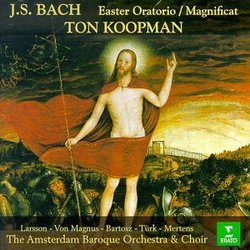| All Artists: Johann Sebastian Bach, Ton Koopman, Lisa Larsson, Elisabeth von Magnus, Klaus Mertens, Gerd Türk, Bogna Bartosz, Amsterdam Baroque Orchestra and Choir Title: J. S. Bach: Easter Oratorio/Magnificat (Ton Koopman) Members Wishing: 0 Total Copies: 0 Label: Erato Release Date: 3/16/1999 Genre: Classical Styles: Opera & Classical Vocal, Historical Periods, Baroque (c.1600-1750), Symphonies Number of Discs: 1 SwapaCD Credits: 1 UPC: 639842341622 |
Search - Johann Sebastian Bach, Ton Koopman, Lisa Larsson :: J. S. Bach: Easter Oratorio/Magnificat (Ton Koopman)
 | Johann Sebastian Bach, Ton Koopman, Lisa Larsson J. S. Bach: Easter Oratorio/Magnificat (Ton Koopman) Genre: Classical
Bach's celebration of Easter is a mostly joyous one, opening with a three-movement sinfonia, richly orchestrated, and complete with trumpets and drums: the third movement includes the chorus inviting listeners to rejoice a... more » |
Larger Image |
CD DetailsSynopsis
Amazon.com essential recording Bach's celebration of Easter is a mostly joyous one, opening with a three-movement sinfonia, richly orchestrated, and complete with trumpets and drums: the third movement includes the chorus inviting listeners to rejoice and hasten to the tomb of Jesus, "For our Savior has awakened." There follow recitatives and arias for Mary Magdalen, Mary, the mother of James, Peter, and John. Each character goes through grief to love and gratefulness, and Bach's endlessly inventive scoring, melodic lines, and changing orchestral textures take us on a rich, 40-minute musical journey to peace. Only a too-long soprano aria tends to wear. The Oratorio is coupled on this CD with Bach's justly famous 12-movement setting (in 25 minutes) of the Magnificat text from Luke. Also elaborately scored, with the vocal choices, tempos, and mood changing every couple of minutes, this is one of the great works of Western liturgical music (Gardiner's masterly reading of this work is a must-have). The performances, on Baroque instruments and with crisp, clean, unsentimental Baroque style, are exemplary. Rejoice! --Robert Levine Similar CDs
|
CD ReviewsWhat a fun performance and glorious sound! Craig Matteson | Ann Arbor, MI | 07/08/2002 (5 out of 5 stars) "This recording is full of energy and joy. The period instruments sound so wonderful and lush. It was recorded in just the right environment and sounds superb.The approach to both pieces is spot on and you will want to listen to this recording many times just for the sheer fun of it.The provided booklet provides some helpful notes on the background of the pieces - when and why Bach wrote them. And also the libretto (which is ALWAYS nice to have). I like to have all that information available and knowing when and why can deepen our appreciation of the music. However, the first and most important thing is to hear the music.This recording is among the best of these works. So, you would do well to begin here!" What an up! J. C. Woods | Malden, MA USA | 04/13/2000 (5 out of 5 stars) "Ok, I don't speak German. It doesn't matter.The opening bars of this CD are so pleasing, excited, joyous, thrilled they break the language barrier. You know easter is here. Then they turn to the Magnificat. A wonderful rendition.This is the version that will be my standard." Powerful Kantor's Easter & Magnificat Efforts rodboomboom | Dearborn, Michigan United States | 05/09/2002 (5 out of 5 stars) "1723-25 were powerful, productive years for Bach in Leipzig as Kantor. In 1723-24 Christmas, comes this Magnificat. Especially attractive to me is track 14, "Aria" "Quia respexit humilitatem" which is a powerful soprano and oboe movement aided by the full chorus piping in "To all Generations!"The Easter Oratorio was a gift for an honorarium by Duke Christian composed around four aria recitatives for Mary Magdelene, Mary, John and Peter. The opening Sinfonia is breathtaking with its gracious oboe work by Marcel Ponseele.
Building to the heights of the finale, "Praise and Thanks" ends in triumphant declaration by full choir "The Lion of Judah approaches in triumph!"Strong vocalist performances by soprano Lisa Larsson and bass Klaus Mertens. Amsterdam Baroque Orchestra and Chorus directed by Ton Koopman is well done with passion and pace.With translation in French, German and English, this is excellent performance of important Sacred Large-Scale Composition for soloists, choir and orchestra." |

 Track Listings (23) - Disc #1
Track Listings (23) - Disc #1


